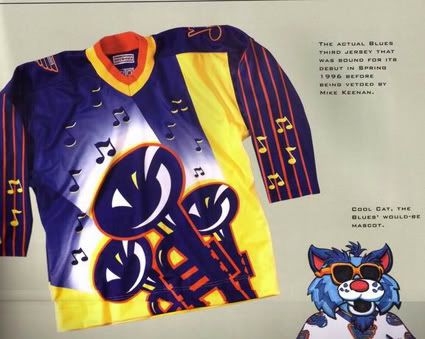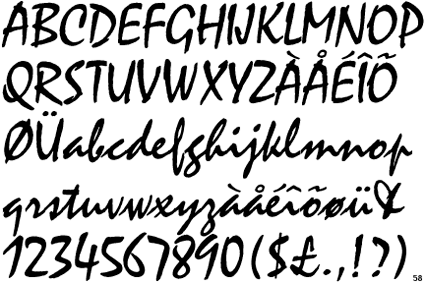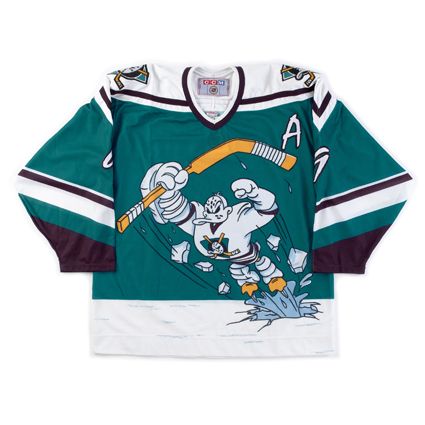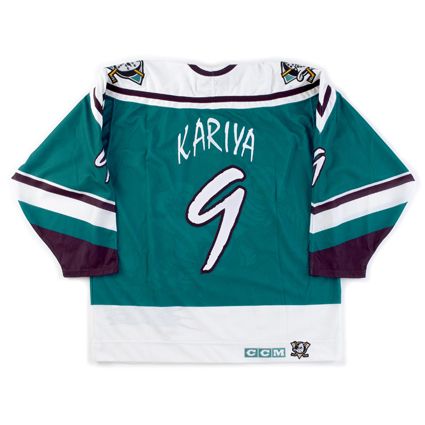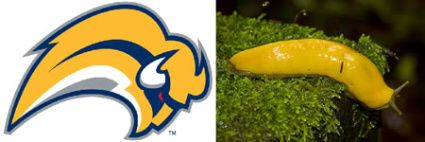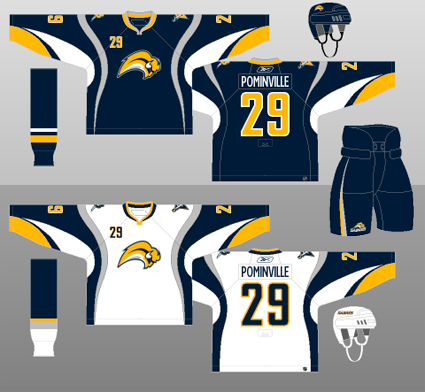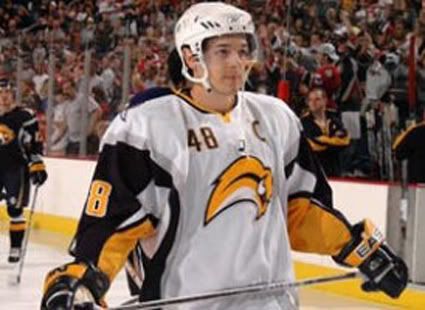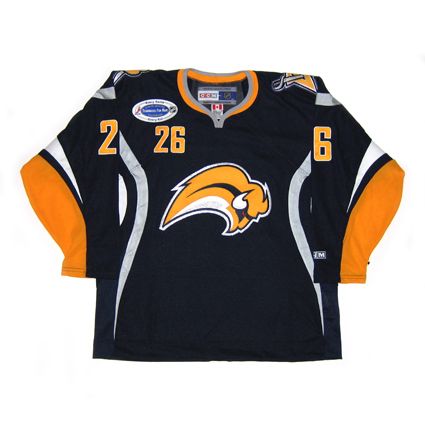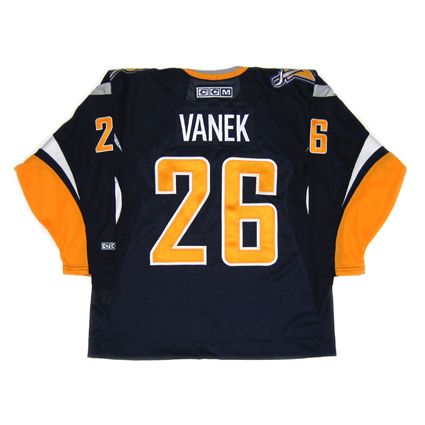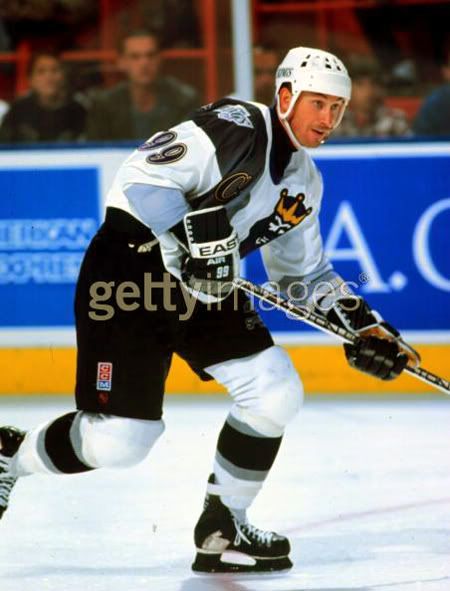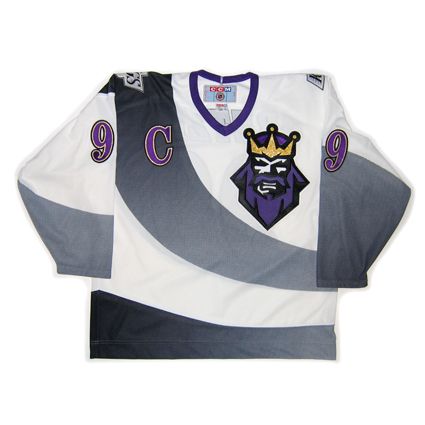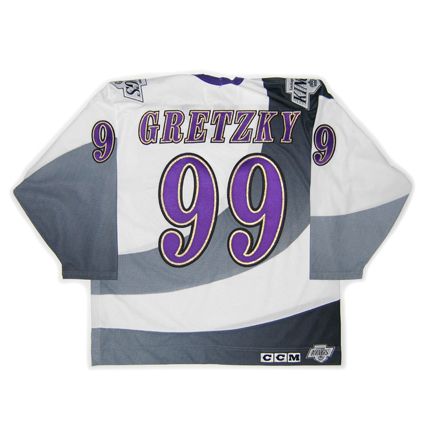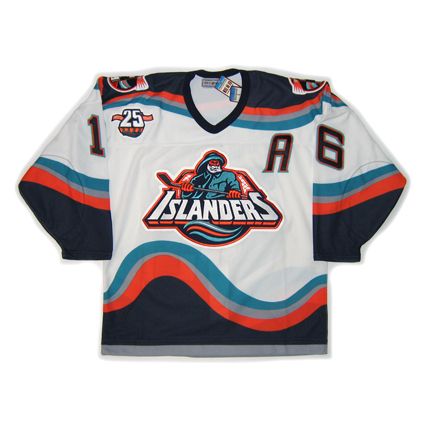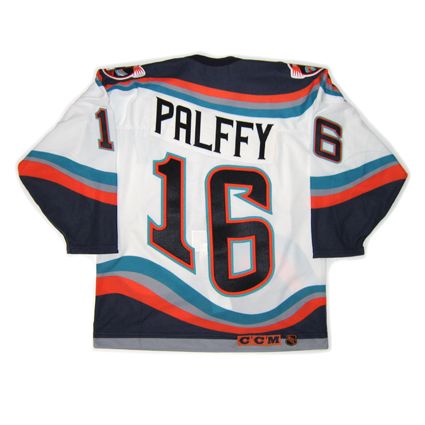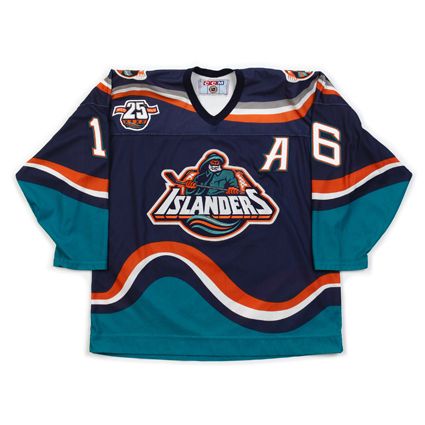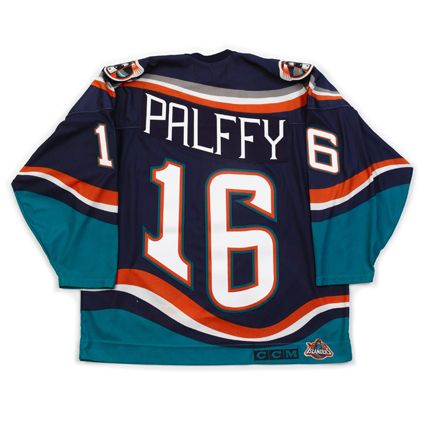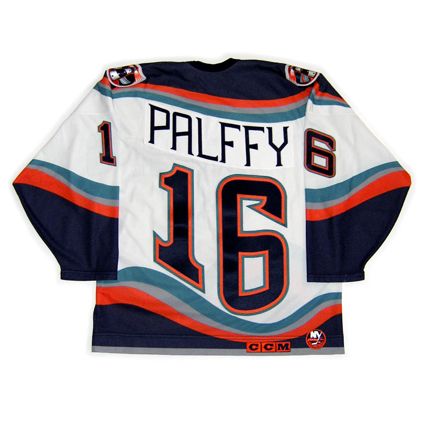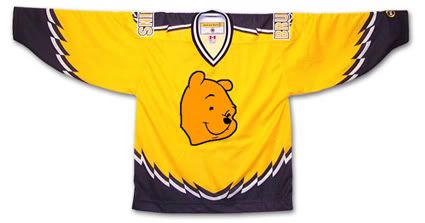Saturday, August 22, 2009
1995-96 St. Louis Blues Wayne Gretzky Jersey
Friday, August 21, 2009
1995-96 Mighty Ducks of Anaheim Alternate Paul Kariya Jersey
Thursday, August 20, 2009
2003-04 Dallas Stars Alternate Mike Modano Jersey
"The new logo depicts a constellation of individual stars aligning to form an unstoppable force of nature, a charging bull. Get it? A constellation of stars aligning to form an unstoppable force? "
Only that's not how the critics saw it. Oh no. The bull's head immediately reminded many of a diagram of a woman's uterus, and was derisively nicknamed "The Mooterus" - a combination of a cow's "moo" and a woman's "uterus" for those of you who haven't heard the nickname before, elevating it to the lofty status of the "named jersey", a sure sign of infamy.

The jersey, which was not very well received, was worn for two seasons, 2003-04 and 2005-06. Teams are required by the NHL to market their new alternate sweaters for a minimum of 15 games for their first season of use. The Stars reduced that number to eight games for 2005-06 and refused to commit to the same amount for 2006-07, which would have been the final season for The Mooterus anyway because of the league-wide redesign coming in 2007-08.
Dallas Stars owner Tom Hicks was quoted as saying on the occasion of The Mooterus' final game on April 3rd, 2006, "Good riddance. The funny thing is that you can't find anyone around here who will take credit for designing it. Nobody's left."
Jill Moore, the Stars Senior Director of Merchandising, said one of the problems with the bull's head logo was that it was designed undercover by an outside service during the days of the Southwest Sports Group. The conglomerate had a plan - trying to mix the thought of a constellation, stars, with a Texas icon, the bull head.
The team did make $400,000 from sales of the jersey and went 13-7-3 while wearing it, but the mixture of too many ideas combined with a lack of testing led to the backlash against it.
There were no additional patches worn on the jersey in either season of it's use.
I classify this jersey as clearly "Ugly" due to the unexplained inclusion of red, which was not only not a Dallas Stars color, but the way it looked combined with the predominately black jersey and the dark shade of green used by the Stars. Overall it was a dark and depressing jersey even before the logo was applied to it.
As for the logo itself, as stated above, there was just too many ideas combined for it to ever work. Perhaps a simplified bull's head logo with a single star (which worked up the road in Houston quite nicely) rather than the constellation overlay might have been more effective, in the way that the Calgary Flames horse head logo paid homage to the Calgary Stampede and the city's western heritage, with just enough flames to tie it to the team's name.
As it was, the logo just didn't look enough like a bull's head, overshadowed by the busyness of not only the stars placed on it, but the lines connecting them as well. The unnecessary shooting star on the logo only added to the visual confusion since there were already stars pictured inside the bull's head. The streak of red behind it only served to grab the viewer's eye away from the more muted tones of the black and green bull's head.
Then there was the unfortunate resemblance to the female reproductive system which reduced the entire thing to a laughingstock. In hindsight, they should have at least curved the bull's horns upwards to diminish the comparison to the medical diagrams since they were not being faithful to the actual constellation of Taurus in the first place.
Also odd was the decision to not use any red in the customization specifications. The colors used for the names and numbers, taken straight from the green home jerseys look out of place on the alternate since the gold color trim on the numbers does not match the gold color of the stripes on the jerseys. Perhaps changing the black trim of the names and numbers to red might have made them look like they were meant to be on the jersey from the beginning and would have helped tie the entire package together justifying the appearance of the red on the jersey in the first place. As it was done, the jersey and the customizing don't look like they were meant to be together on the same sweater.
Since these jerseys were only worn for a total of 23 games, let's see what kind of luck I can have looking for video of them in action, although you probably can predict by now that if I do find any game footage, it will most likely be fisticuffs...
Sure enough...
Here's some actual skating and passing featuring Stu Barnes.
Wednesday, August 19, 2009
2006-07 Buffalo Sabres Thomas Vanek Jersey
Tuesday, August 18, 2009
1995-96 Los Angeles Kings Alternate Wayne Gretzky Jersey
Monday, August 17, 2009
1996-97 New York Islanders Ziggy Palffy Jersey
Kirk Muller popped into the home dressing room at Nassau Coliseum on a sunny June afternoon during the Stanley Cup finals in 1995. This was the big debut of the Islanders' new uniforms, the first glimpse of what many fans and media members immediately crowed was a blasphemous move by management to make a final break from the team's storied past.The public relations fiasco that would be known as the Islanders' 1995-96 hockey season actually started near the end of the previous campaign, when Don Maloney committed the signature sin of what would be a short tenure in the general manager's office. He traded his best player, Pierre Turgeon, in a five-player deal for Kirk Muller, a widely respected leader who simply wanted no part of leading the Islanders bak to the playoffs after they failed to qualify during the lockout-abridged 1994-05 season.If Maloney's worst crime was his misguided belief that his first blockbuster move would benefit he Islanders on the ice, the four-pronged managment group's decision to alter the team's fashion sense only accelerated their transformation into league laughingstocks."We never intended to strip the team of it's tradition," Islanders co-chairman Bob Rosenthal said. "But we made a mistake. We did not read the signals correctly. We misunderstood the underlying passion of the fans."The team's dwindling yet impassioned fan base never forgave (former Islanders General Manager Don) Maloney for the Turgeon trade, not even after Maloney and (Kirk) Muller were both mercifully expunged from the organization over the next nine months. But the logo fiasco served as a rallying point for a segment of fed-up paying customers who suddenly found themselves forming activist groups and oranizing protest rallies rather than worrying about the power play or Stanley Cup playoffs."We believed that many of the people who had followed the team in the late seventies and eighties had moved off the Island," Rosenthal said. "Their kids had grown, and maybe they moved away as well. The season ticket base, which had been 13,000 to 14,ooo at it's peak, had dropped to 5,000, so we not only were looking to improve our play on the ice, we started looking for ways to attract new fans."In retrospect, the probably should've found another way.For the first 23 years of their existence, the Islanders' uniforms were adorned with a simple logo, a circled crest of Long Island that also included an "NY" with the "y" appearing in the form of a hockey stick. It was designed on just three days' notice by John Alogna, who owned a Garden City ad agency, in 1971, and it quickly became synonymous with the Islanders as they ascended from expansion franchise to NHL champions.Still, after the 1993-94 season ended in a disgraceful first-round playoff sweep by the Rangers, Islanders management "began to feel that younger fans were starting to think about the old logo in terms of the futility of the previous years, not the four Stanley Cups," according to Rosenthal.The NHL, buoyed by the marketing and sales success of merchandise adorned with logos of new franchises such as the Mighty Ducks of Anaheim and the San Jose Sharks, encouraged the Islanders to consider making a change, more in line with other cutting-edge sports fashions. The league recommended SME Design in Manhattan, which had modernized the uniforms of the St. Louis Blues and also designed the logo of the expansion Florida Panthers and other pro and college teams.Initially, Walsh and vice president of communications Pat Calabria served as the point men for ownership."The Islanders were living in the shadow of the Rangers," designer Ed O'Hara told Newsday's Steve Zipay in 1997. "We all agreed that a strengthened tie to Long Island was important, to keep the heritage of the Island and amplify it. Savvy marketers will tell you to think locally."As New Coke and Pepsi Clear showed, sometimes it's better to leave well enough alone.Walsh, who allowed his children's opinions to influence his decision, had a vision of a maritime theme. SME submitted a proposal to the Islanders with three to five concepts. In April, designs with various colors and logos of a lighthouse, a bearded grimacing mariner and the steering wheel of a fishing boat were offered."Everyone agreed that the bayman was the one, although the entire process was a huge concern. There was always self-doubt," O'Hara said. The NHL approved the entire concept in early fall of 1994 for implementation during the 1995-96 season.Beat writer Colin Stephenson of the Daily News was the first to report the changes and updated colors, remarking how the chosen logo resembled the frozen-food advertising icon Gorton's fisherman. In a photograph accompanying the story, former captain Denis Potvin was pictured hoisting the Stanley Cup while wearing a computer-generated uniform adorned with the new logo and deeper color schemes. SportsChannel announcer Stan Fischler was cited as bearing a remarkable resemblance to the logo fisherman.Barely one week after the official introduction on June 22, 1995, 78 percent of 1,006 respondents to a Newsday poll asking for responses panned the new logo. To prove there's no accounting for the taste of the consumer public, Team Licensing Business, a publication that tracks purchases of sports apparel, reported as of March 31, 1996 that the Islanders have moved up to No. 17 of the 26 clubs in jersey sales. According to the NHL, that was three or four slots higher than the previous season.Still, the Islanders fans deplored the blasphemous changes, with many comparing it to the Gorton's fisherman. That comparison prompted Rangers fans to mockingly chant, "We want fish sticks!" when the Islanders visited Madison Square Garden for the first time that season.Peitions were drawn up and signatures gathered. The Gang of Four was chided mercilessly at Nassau Coliseum, including an ugly incident in which Palleschi's teenaged daughter was booed while singing the National Anthem before one game. A small but vocal contingent of disgruntled fans even formed a group that initially was spawned in protest of the logo."With change comes risk; with change comes unhappy fans," Rosenthal said. "As the team continued to lose, fans needed something to cling to and homed in on the logo. We began to realize it was not dying down. In the final analysis, we didn't want our fans or players to be subjected to ridicule for something other than our play."To be sure, there was plenty of room to mock all aspects of the operation. Ultimately, the one thing that all sides agreed on was that the fisherman logo became the lightning rod for all of the team's misfortunes and the focal point of fan frustration "There's no doubt it was the scapegoat. But winning would have helped," O'Hara said.On April 11, 1996 - a few games before the end of another disastrous season - the Islanders announced plans to restore the old logo for 1997-98 while retaining the new colors and wavy designs."Good," Islanders defenseman Darius Kasparitits told reporters after he was informed of the reversal back to the original logo. "We looked like idiots."
Sunday, August 16, 2009
1998-99 Boston Bruins Alternate Ray Bourque Jersey
First introduced in 1995, this jersey was the longest surviving of the original alternate NHL jerseys, lasting until the 2005-06 season. Dubbed the "Winnie the Pooh" jersey, it features a primary logo with perhaps the most docile looking bear this side of Gentle Ben. It's buttery gold color also does nothing to strike fear into the hearts of the Bruins opponents either.



